Early Repeat Firing and Revolver Guns
The repeat firing machine gun was a new weapon in
the late 19th century. Early types of multi-round Millitareuse and Gatling guns with
multiple barrels had
seen action during the American Civil War and been used by the French against the
German armies in the Franco-Prussian War. Some of these early
weapons were also occasionally used in colonial
warfare.
One early repeat firing weapon that
did see colonial action (but due to its calibre of shells should
more properly belong on the
Artillery Page) was the 1873 Hotchkiss 37mm Revolver
Cannon. This was a hand cranked gun with revolving barrels
that was often fitted aboard naval ships and was sometimes used
on land in the colonies in times of need (such as those of
the SMS Habicht used in South West Africa during the Herero
Rebellion).
The Maxim Gun and its Effect on Warfare
In 1884 Hiram Maxim
invented the first modern machine gun. It had a single water
cooled barrel and fired rounds fed from a belt. Soon all European armies adopted
the Maxim gun or began to produce their own licensed version of
it.
The Maxim Gun revolutionised
warfare and to a large extent caused the stalemate of the
western front in the First World War as it was a very effective
defensive weapon but because it had to be dismantled and carried
by a crew of three or four men before being reassembled in a
new firing position was of limited use when on the offensive meaning that in
a battle the defender in a well prepared position always had the advantage.
In the colonies, machine guns were
particularly effective in terrifying locals with a brief blast
of fire or against
whole tribal armies attacking en masse, as was seen at the Battle of Mahenge in 1905 in German East Africa, where the Schutztruppe
12. Feldkompagnie armed with two machine guns fought off around 8,000
warriors causing around 600 casualties among them, while not
losing a single German or Askari casualty themselves. In a prepared
defensive situation such as this the machine gun was
devastating.
Without preparation the machine gun
was useless. Its weakness was its
relative immobility and the time spent setting it up which
made it prone to ambush, as happened at the Battle of Lugalu
in East Africa in 1891, where despite being equipped with
machine guns, the Schutztruppe were so entirely overwhelmed by the
sudden Hehe attack that they did not get a chance to deploy the
guns before
they were overrun. Against an elusive foe they were of
equally limited use.
During the
First World War in Africa the machine gun was essential to the defenders
of the German colonies against a similarly armed foe. In the
colonies as on the Western Front, when used in defensive or
counter attacking actions such as seen at the Battles of
Sandfontein in South West Africa, the River Chra in Togo and
Tanga in East Africa, the coordinated use of machine guns could be
decisive.
Types of Machine Gun Used the the
German Colonies
The German made
MG01 based on the Maxim design was by far the most
commonly used machine gun in the German colonies but
several others saw limited use. Aside from the very
first Maxims, which fired 11mm rounds later German
produced Maxims fired the same 9mm rounds as used with
G98 rifles. Existing early guns were then re-fitted to
accommodate the new ammunition. While the German army
usually issued its machine guns with a heavy sled ('or Schlitten')
mounting those in naval and Schutztruppe service are
most commonly seen with a tripod stand.
1887 World Standard Maxim
Gun
Maxim's gun was first mass produced
in England and marketed as the
Maxim World Standard Machine Gun from 1887. The first Maxim guns deployed by the Germans for action
were World Standard Maxim guns of the Imperial Navy in
the Samoan Civil War 1888-89. These World Standard Guns
fired 11mm rounds, which was the standard rifle
ammunition of the Prussian Infantryman at the time. Kaiser Wilhelm II himself
tried the World Standard Gun in 1888 and was suitably
impressed by it. He donated this weapon to the
Wissmanntruppe expedition to East Africa the following
year.
Marine
Maschinengewehr
M94
It was
Ludwig Loewe & Co of Berlin that
licensed the Maxim design in Germany in 1892 (the company was
renamed Deutsche Waffen- und Munitionsfabriken Aktien-Gesellschaft
or DWM from 1896). The Imperial Navy first placed an order for
these guns in 1894, introducing them as the
Maschinengewehr M94 or MG94.
These remained in naval service into the First World War,
although by 1914 the navy had also begun using the updated MG08.
Maschinengewehr
M01
The German army also showed an interest and ordered their first
machine guns from DWM five years later as the MG99 in very
limited numbers. The
Maschinengewehr M01 or MG01
followed with modifications and was again used in small numbers
(only a few hundred were manufactured) by the German army. It
was however the MG01 that was most commonly used by the
Schutztruppe in Africa and also Marine Infantry of the Tsingtao
garrison.
Maschinengewehr
M08
Later modifications including replacing cast iron
parts with alloys to reduce the weight led to
the Maschinengewehr M08 or MG08, which was the standard machine gun used by the
German army in the First World War. The MG08 was made by both the DWM and the Spandau arsenals in Berlin.
Over 12,000 MG08 guns were issued to the German army and navy by
1914. Though the MG08 was a standard weapon on the Western and
Eastern Fronts as well as in Palestine during First World War,
they were rarely issued in the colonies.
Machine Cannons-
the
Maschinenkanone M97
The basic Maxim belt feed design was also used for
guns of a larger calibre, most notably the
3.7cm Maschinenkanone M97 manufactured
by Krupp. This weapon
was first put into action by the Imperial Navy in South West
Africa during the Herero Rebellion. Around eight naval MK97 guns
are believed to have been deployed during the Herero Rebellion
and to have remained in South West Africa until the First World
War.
British Lewis Light Machine Gun
While
the Maxim gun and its licensed versions were a breakthrough in
military technology, their weight and immobility were their most
obvious weakness. Several attempts were made to make machine
guns more manoeuvrable in the years before and during the First
World War. This was usually done by lightening the weapon
wherever possible, using air cooling systems rather than
carrying a tank of water, introducing a shoulder butt and by
replacing belt feed ammunition with magazines. Common wartime
examples of this design are the German MG08/15 (which did not
see service in the colonies), the French Chauchat and the
British Lewis LMG. The latter of which when captured was often
used by the Schutztruppe in East Africa and the Ottoman army in
Palestine during the First World War.
Bergmann Light Machine Gun MG
M15nA
The
Bergmann LMG M15nA
was one such light machine gun, it was designed by Theodor Bergmann and produced for the German army
and newly formed air force, although it never replaced the MG08
or MG08/15. It had a 200 drum round magazine, shoulder stock and
bipod stand. Several of these Bergmann guns were by the
Asienkorps in Palestine from 1917.
German Overseas Machine Gun Deployments
At the outbreak of war in 1914 the garrisons
of all four African colonies (South West Africa, East Africa,
Cameroon and Togo) and the port of Tsingtao in China were armed
with machine guns. The Pacific colonies of New Guinea and Samoa
by contrast had no machine guns. Ships of the Imperial Navy were
usually equipped with machine guns and repeated firiung cannon
which could be deployed on land in the colonies in times of
rebellion and war.
South West Africa
The first machine gun used in South West
Africa was a naval MG94 deployed on land from the SMS Habicht in
1904 in their initial reaction to the outbreak of the Herero
Rebellion. More naval machine guns soon followed from other
ships and the Marine Infantry, bringing the total to eight. Six
MG01 machine guns were brought by the Schutztruppe
reinforcements later that year.
By 1914 the Schutztruppe had two machine guns per field company. Most
were mounted on wheeled carriages, though those of the 3. Feld Kompagnie
were not wheeled and were carried by pack animals. The Schutztruppe use of machine guns in setting up an ambush
for the South African invasion force at the Battle of
Sandfontein in 1914 proved decisive in the
German victory. According to Werner Haupt in 'Die deutsche
Schutztruppe', the Schutztruppe of South West Africa had twenty
four machine guns in service in 1914.
East Africa
The first machine gun in East Africa was the demonstration model
World Standard Maxim gun that had been presented to Kaiser
Wilhelm II. The Kaiser was suitably impressed and donated this
first gun directly to the Wissmanntruppe. It fired 11mm black
powder rounds.
Over the years and especially during
the Maji-Maji Rebellion the machine gun strength was updated and
increased until by the outbreak of war in 1914, the
Schutztruppe of East Africa had a total of fifty five
machine guns in service (according to Werner Haupt in 'Die
deutsche Schutztruppe'). These were MG01 or MG08 models
deployed as two or three per Field Company with
remainder in fixed defensive portal positions or in
depot at Dar Es Salaam. During the war, the Schutztruppe
also benefitted from several naval MG94 machine guns from German
naval ships such as the SMS Königsberg and SMS Möwe, as they
were scuttled. In 1915 and 1916 two German supply
ships, the SS Rubens and SS Marie each brought four MG08
machine guns to the Schutztruppe with their European
sled mountings (one of these guns still survives in the
South African Naval Museum in
Simonstown).The
tactical use of the Schutztruppe machine guns in
defensive positions at the Battle of Tanga in 1914 was one the
decisive factors of the German victory. After the battle
they were able to capture sixteen British Vickers
machine guns (the British licensed variant of Hiram
Maxim's original gun). Throughout the war many more captured
British and later Portuguese machine guns were put to use by
the Schutztruppe. By November 1918 when they
finally laid down their arms, the Schutztruppe still had twenty-four machine guns and fourteen Lewis guns.
Cameroon
According to Werner Haupt in 'Die
deutsche Schutztruppe', the Schutztruppe of Cameroon had
sixty machine guns in service in 1914. This seems an
unusually high number when compared with only twenty
four in the usually better equipped, South West African
Schutztruppe. Yet the superiority of
German machine gun fire is referred to on several
occasions in the British Official History of the Campaign
as a reason why it took so long to defeat isolated
German outposts in Cameroon.
Togo
According to Werner Haupt in 'Die
deutsche Schutztruppe', the Polizeitruppe of Togo had
four machine guns in service in 1914. Three of these
were used with great effect in entrenched positions to
repulse British and French attacks during the Battle of
the River Chra in 1914.
New Guinea and Samoa
The Polizeitruppe of the Pacific colonies did not
have machine guns, though machine guns were deployed by landing parties
of the Imperial
Navy during the
Samoan Civil War 1888-89 and the
Sokehs Rebellion 1910-11.
China
The German East Asian Expeditionary
Corps were not equipped with machine guns to face the Boxer
Rebellion of 1900. Neither at
that time were the III. Seebataillon stationed at Tsingtao and
Peking. Other allied armies did however have machine guns during
the uprising; the US Marines at the Peking Legation had a
Colt–Browning M95 machine gun and
the Austro-Hungarian navy brought Skoda
Mitrailleuse M93 machine guns with
them.
After the rebellion a machine gun
company was added to the East Asian Occupation Brigade
and in 1911 a machine gun
company was added to the III. Seebataillon. These both consisted
of six MG01 guns all equipped with the original sled mounting. The
naval fortifications of Tsingtao also had machine gun
emplacements.
Ottoman Fronts
Before the outbreak of war, the Ottoman army already
been equipped with some exported German MG08 machine guns. Many
more were
supplied during the war. The Germans also gave large numbers of
captured Russian Maxim guns to the Ottoman army during the war. However, these
weapons were spread across a large army over several fronts of
their empire and German units heavily armed with machine guns were
often deployed to back up the Turkish army.
The first German
machine guns deployed to the Gallipoli front were several MG08 guns and
their crews from the ships SMS Goeben and SMS Breslau. The Pascha I Expedition in deployed to the Sinai
front in 1916 had
eight machine gun companies
(Maschinengewehr-Kompanien
601-608) each equipped with six MG08s. The Pascha II Expedition
of 1917 included
the
701st Infantry
Battalion with another six MG08 machine guns
and later eighteen
Bergmann LMGs. Pascha II was reinforced in 1918 by the 146th Infantry
Regiment ("1. Masurische Infanterie-Regiment
Nr. 146") whose three battalions each
had six MG08 machine guns and the 11th Reserve Jäger Battalion
who also had six MG08 machine guns.
Recommended External Links
Discussion on
Machine Guns of the Schutztruppe on the Axis History Forum
Article on the
Maxim World Standard Machine Gun on MaximGun.de
Article on the
German System of Maxim Machine Guns
based on 'Guns in
the First World War' by S Fedoseyev
Article on
German
Maxim Guns
on Cruffler.com
Reference to the first
Machine Guns in South West Africa on
Omaheke.Blogspot.co.uk
MG01 Article on
MaximMachineGun.com
Discussion on
Asienkorps
Bergmann LMG 15nA on the
Axis History Forum
Published Sources
'German Machine
Guns of World War I'
by Stephen
Bull (Osprey)
'Die Deutsche
Schutztruppe 1889-1918' by Werner Haupt (Dörfler)
'Die
Kaiserliche Schutz- und Polizeitruppe für Afrika'
by Reinhard Schneider (Druffel
& Vorwinkel-Verlag)
'The Battle of Tanga
1914' by Ross
Anderson (Tempus)
|
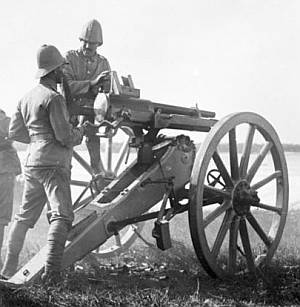
German East African Schutztruppe, c1914
with a Hotchkiss M73
37mm Revolver Cannon
mounted on a C73 gun carriage
Photo
by Walther Dobbertin at
WikiCommons / Bundesarchiv
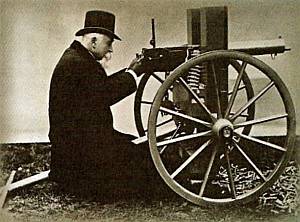
Hiram Maxim and his
World Standard Machine Gun
Photo
WikiCommons
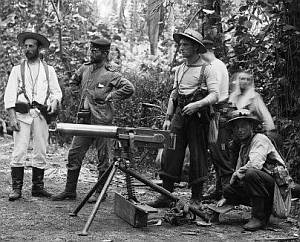
German Naval
Landing Party, Samoa 1888-89 with an M87 Maxim World Standard
Gun
Photo from
House of Pereira
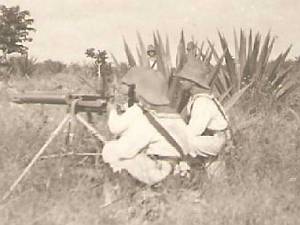
SMS Königsberg Crew,
East Africa 1914-15
with an MG94
Naval Machine Gun
on a tripod mounting
Photo
© Peter Klein
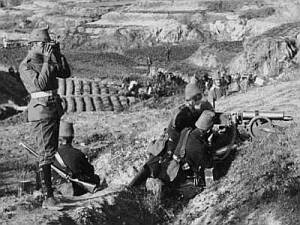
MG Company of the III.
Seebataillon, Tsingtao
with an
MG01 Machine Gun
Bundesarchiv /
WikiCommons

3.7cm
Maschinenkanone M97
of the South West African
Schutztruppe
Photo by Phil Buhler at Tsumeb Museum, Namibia
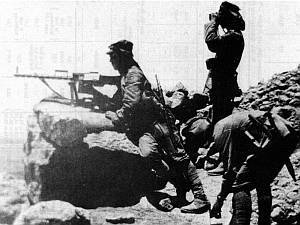
Asienkorps Palestine c1917/18
with a Bergmann M15nA LMG
Photo from
Billkilgore.de , originally published in "Kampf in
der Wüste" by Laar von Clemens Laar, Verlag Bertelsmann,
Gütersloh 1936
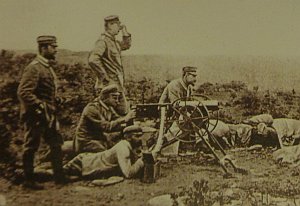
South West African
Schutztruppe c1904
with an MG01 Machine Gun on a sled mounting
Postcard C Dale
Collection
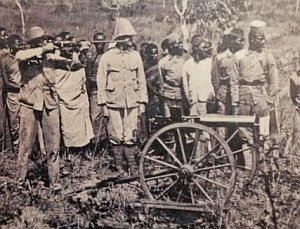
East African Schutztruppe 1897
with the World Standard Maxim Gun
Premier Leutnant Engelhardt demonstrates his weapons
to the chiefs of Ungoni including Germany's first World
Standard Maxim gun presented to the Wissmanntruppe by
Kaiser Wilhelm II. Note the wheeled gun carriage.
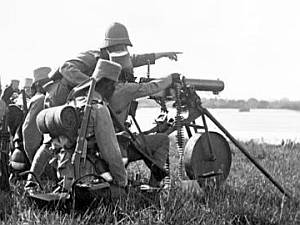
East African Schutztruppe c1914
with an MG01 Machine Gun
Photo
by Walther Dobbertin at
Wikimedia / Bundesarchiv
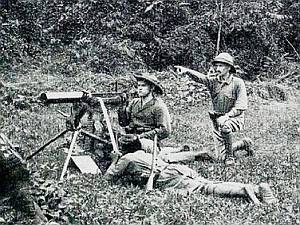
Cameroon Schutztruppe
c1914
with an MG01 Machine Gun on a Tripod Mounting
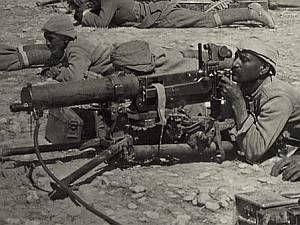
Turkish Army on the Gaza Front 1917
with an MG08 with telescopic sight and
an M09 Tripod Mounting
Photo Wiki
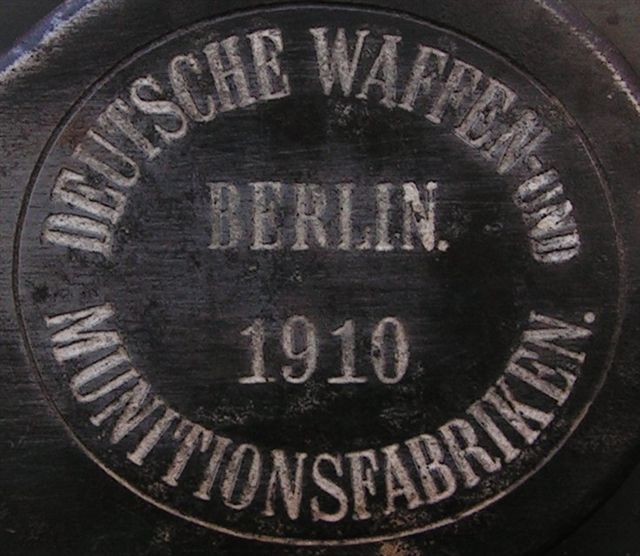
Markings of the DWM on an
MG08
Photo © Gilles Sigro
|